The Republic of Ezo (蝦夷共和國, Ezo Kyōwakoku) was a short-lived separatist state established in 1869 by a part of the former military of the Tokugawa shogunate on the island of Ezo, now known as Hokkaido, at the end of the Bakumatsu period in Japan. It is notable for being the first government to attempt to institute democracy in Japan, though voting was allowed only to the samurai caste. The Republic of Ezo existed for only 5 months before being conquered by the newly established Empire of Japan.
蝦夷共和国(えぞきょうわこく、英: Republic of Ezo)とは、戊辰戦争末期に蝦夷地(北海道)を支配した旧江戸幕府軍勢力による「事実上の政権」である蝦夷島政府を指す俗称。蝦夷政権、箱館政権、北海 道共和国[1][2]とも言う。
概説
慶応3年(1867年)に15代征夷大将
軍徳川慶喜が大政奉還を行って江戸幕府が消滅し、山岡鉄太郎の斡旋により新政府軍の大総督府参謀である西郷隆盛と徳川家陸軍総裁の勝海舟の会談で江戸城の
無血開城が決定した。慶応4年(1868年)8月19日夜、海軍副総裁の榎本武揚は開陽丸を旗艦とする軍艦4隻(開陽、回天、蟠竜、千代田形)と運送船4隻
(咸臨、長鯨、神速、美賀保)の8隻の艦隊を率いて蝦夷地の箱館に向かった[3]。途中仙台で会津戦争で敗走した残党などを吸収して、総勢二千数百名とな
り、10月20日に鷲ノ木に上陸[3]。上陸後、数日で五稜郭を攻略し、箱館を占領した[3](箱館府知事清水谷公考は敗走した)。
12月15日には蝦夷地全島平定の祝賀祭(蝦夷地領有宣言式)が催され、榎本を総裁とする仮政府の樹立を宣言した[3][4]。
明治元年(1868年)10月に榎本が函館入港中の英仏両艦長に明治新政府との仲介を依頼した「榎本武揚等歎願書」によると、榎本は蝦夷地に向かった目的
について、徳川家の禄高が70万石に制限されたことによって禄を離れざるを得ない旧幕臣を蝦夷地に入植させ、農林漁業や鉱業などを興すとともに、ロシア帝
国の南下に対する北方警備につかせることを画策したと説明している[3]。
新政府は嘆願を拒否し1869年3月征討軍を派遣、4月9日政府軍は江差北方の乙部に上陸、5月11日箱館を占領した。政府軍参謀黒田清隆は五稜郭にこも
る榎本らに降服を勧告、榎本は18日には開城し、新政府による国内統一が完成した[5]。
性格
榎本らは総裁として徳川家の血統を引く者
を迎えることを希望していた[3]。一方で榎本は王政復古による「皇国」をあからさまに否定したことはなく、1868年8月の榎本の「檄文」は「王政日新
は皇国の幸福、吾輩も亦希望する所なり」と述べつつ「強藩の私意に出で、真正の王政に非ず」と新政府側の諸藩を非難している[3]。
呼称
榎本らにより表明された文書に「共和国」
の名が現れたことはなく、「共和国」の名は仮政府の周囲の者によって呼ばれるようになったにすぎない[3]。
最初に「共和国(リパブリック)」という表現を使ったのは、1868年11月、英仏軍艦艦長に随行し、榎本と会見した英国公使館書記官フランシス・オッ
ティウェル・アダムズだった。彼が1874年に書いた著書 History of Japan において、箱館政庁を "republic"
と紹介し、その後、アダムズの表現に倣う者が大多数となった。
旧幕府脱走軍が鷲ノ木に上陸した後、密偵の小芝長之助らが函館在留の各国領事宛にフランス語で書かれた脱走軍の声明文を届けているが、そこでは「徳川脱藩
家臣」(Les Kerais exiles de Toukugawa)という署名が用いられている[6]。
なお、ウィリアム・グリフィスは著書の『ミカド』で「北海道共和国」として紹介している[3]。
「事実上の政権」
戊辰戦争で英、仏、蘭、米、普、伊の6か
国は局外中立の立場をとっており、榎本らは局外中立が維持されるよう諸外国の信頼を得る必要があった[3]。榎本らは国際法の交戦団体としては認められな
かったが、1868年11月にイギリスやフランスから「事実上の政権 De Facto」に認定されている[3]。
榎本軍が箱館を占領した後、1868年11月4日、英軍艦サトライト、フランス軍艦ヴェニウスは、英公使ハリー・パークスより訓令を与えられ、英国公使館
書記官アダムズを同行させて箱館に入港した。この時、弁天台場は、両艦を歓迎する礼砲を撃ったが、両艦とも無視した。
翌11月5日、現地の英仏領事と両艦の艦長が会同して打ち合わせを行ったが、英仏領事とも、この時点では榎本軍に対して高い評価を与えていた。やがて箱館
港を管理する箱館奉行永井尚志に来てもらったが、榎本は松前に出張中であり、帰るまでしばらく待って欲しいと答えた。永井は外交経験も豊富であり、彼の態
度は、英仏領事のみならず、英仏艦艦長にも好印象を与えた。その会同の最中、榎本艦隊旗艦開陽丸が、賓客の来訪を歓迎する21発の礼砲を撃った。これを見
たアメリカ、ロシア帝国、プロイセンの領事は、英仏艦に行かずに開陽丸を表敬訪問した。
11月8日、榎本は英仏領事と英仏艦艦長と会見した。英仏側の言い分は厳しかったが、公法上諒承せざるを得なかった。会談終了後、榎本は、念のためメモラ
ンダムを要求し、英仏艦艦長は諒承した。数日後、彼らは榎本に以下のような覚書を送って来た。
我々は、この国内問題に関しては、厳正中立の立場をとる。
「交戦団体」としての特権は認めない。
「事実上の政権 Authorities De Facto」としては認定する。
12月15日には諸役を決定するための入
札(公職選挙のこと)が実施された[4]。この背景として、脱走軍は榎本武揚が指導者になっているとは言え、元藩主や元幕府老中といった大名クラスも参加
しており、君臣の関係が複雑であったこと。また「陸軍派」と「海軍派」のグループもあり、「陸軍派」の中も、「彰義隊」と「小彰義隊」等の小グループがあ
り、全体として一枚岩に纏まってはいなかったことが挙げられる。ただし、この入札(投票)に箱館の住民は参加しておらず、旧幕府軍でも入札に参加したのは
士官以上の者で旧幕府脱走軍の総数の3分の1程度にすぎず共和制といえるような公選ではなかった[4]。
「投票」総数856票の内訳は、以下の通りであった[7]。
榎本釜次郎 156
松平太郎 120
永井玄蕃 116
大鳥圭介 86
松岡四郎次郎 82
土方歳三 73
松平越中 55
春日左衛門 43
関広右衛門 38
牧野備後 35[8]
板倉伊賀 26
小笠原佐渡 25
対馬章 1
このように榎本武揚が最大投票を得た。た
だし、投票数の2割以下で、圧倒的多数ではなく、各グループごとに投票は分かれている。また、これとは別に役職選挙が行われている。
「総裁」
榎本釜次郎 155
松平太郎 14
永井玄蕃 4
大鳥圭介 1
「副総裁」
松平太郎 126
榎本釜次郎 18
大鳥圭介 7
永井玄蕃 5
荒井郁之助 4
土方歳三 2
柴誠一 1
「海軍奉行」
荒井郁之助 73
澤太郎左衛門 14
柴誠一 13
甲賀源吾 9
松岡磐吉 2
古屋佐久左衛門 1
「陸軍奉行」
大鳥圭介 89
松平太郎 11
土方歳三 8
松岡四郎次郎 6
伊庭八郎 1
町田肇 1
政権首脳
後列左から小杉雅之進、榎本対馬、林董三郎、松岡磐吉、前列左から荒井郁之助、榎本武揚
この「入札」の結果を参考にして、主要ポ
ストは以下のように決定された[9]。
総裁 榎本武揚
副総裁 松平太郎
海軍奉行 荒井郁之助
陸軍奉行 大鳥圭介
陸海裁判官 竹中重固、今井信郎
陸軍奉行並 土方歳三
箱館奉行 永井尚志
松前奉行 人見勝太郎
江差奉行 松岡四郎次郎、 小杉雅之進
開拓奉行 澤太郎左衛門
会計奉行 榎本道章、川村録四郎
海軍頭 松岡磐吉
海軍頭並 甲賀源吾、根津勢吉、小笠原賢蔵、古川節蔵、浅羽甲次郎
歩兵頭:本多幸七郎、古屋佐久左衛門
歩兵頭並:滝川充太郎、伊庭八郎、大川正次郎、松岡四郎次郎、春日左衛門、星恂太郎、天野新太郎、永井蠼伸斎
砲兵頭並:関広右衛門、中島三郎助
工兵頭並:吉沢勇四郎、小菅辰之助
器械頭並:宮重一之助、渋沢成一郎
「入札」で票を得た者全員がポストに就いてはおらず、得票結果がそのまま反映されたわけではない。
軍事
軍事組織
旧幕府軍は陸軍と海軍に分かれ、以下のよ
うな組織となっていた。なお「列士満(レジマン)」と言うのは、フランス語で連隊を意味する Régiment をそのまま当て字にしたものである。
陸軍(陸軍奉行:大鳥圭介、陸軍奉行並:土方歳三)
第一列士満:第一大隊(瀧川充太郎、4個小隊、伝習士官隊、小彰義隊、神木隊)、第二大隊(伊庭八郎、7個小隊、遊撃隊、新選組、彰義隊)
第二列士満(本田幸七郎):第一大隊(大川正次郎、4個小隊、伝習歩兵隊)、第二大隊(松岡四郎次郎、5個小隊、一聯隊)
第三列士満:第一大隊(春日左衛門、4個小隊、春日隊)、第二大隊(星恂太郎、4個小隊、額兵隊)
第四列士満(古屋佐久左衛門):第一大隊(永井蠖伸斎、5個小隊、衝鋒隊)、第二大隊(天野新太郎、5個小隊、衝鋒隊)
砲兵隊:関広右衛門
工兵隊:小管辰之助、吉沢勇四郎
器械方:宮重一之助
病院掛:高松凌雲
海軍(海軍奉行:荒井郁之助)
開陽(澤太郎左衛門、1868年11月江差沖にて沈没)
回天(甲賀源吾、のち根津勢吉、1869年5月箱館港にて自焼)
第二回天(小笠原賢蔵、1869年3月九戸港にて自焼)
蟠竜(松岡磐吉、1869年5月箱館港にて自焼)
千代田形(森本弘策、1869年4月箱館港にて座礁)
神速(西川真蔵、1868年11月江差沖にて沈没)
輸送船:太江丸、長鯨丸、鳳凰丸、長崎丸、美賀保丸、回春丸
フランス人軍事顧問
顧問団と榎本軍。前列左から細谷安太郎、ジュール・ブリュネ、松平太郎、田島金太郎、後列左からアンドレ・カズヌーヴ、ジャン・マルラン、福島時之助、ア
ルテュール・フォルタン。画像中の人物にカーソルを合わせると名前が表示され、クリックでリンク先に飛びます。
1867年から横浜の大田陣屋で幕府伝習隊の教練をしていたフランス軍事顧問団から副隊長ジュール・ブリュネ砲兵大尉ら5人がフランス軍籍を脱走して蝦夷
政権に参加した。その他海軍からの脱走者2人、軍歴を持っていた横浜在住の民間人3人、合計10人のフランス人が蝦夷政権に参加した。ジュール・ブリュネ
は陸軍奉行・大鳥圭介の補佐役となり、4個「列士満」はフランス軍人(フォルタン、マルラン、カズヌーヴ、ブッフィエ)を指揮官としていた。また、海軍の
2人と、元水兵の1人は、宮古湾海戦に参加した。フランス軍人らは五稜郭陥落前に箱館沖に停泊していたフランス船に脱出している。これらフランス軍人の通
訳は横浜仏語伝習所でフランス語を学んだ田島金太郎らが担当した。
大鳥圭介の南柯紀行では、ブリュネを「未だ年齢壮(わ)かけれども性質怜悧(れいり)」カズヌーヴを「頗る勇敢であり松前進軍のときにも屡(しばしば)巧
ありたり」と好意的に書いている。
装備
装備は統一されておらず、隊により洋装・
甲冑など様々であった。
アンリ・ニコールと共に脱走しブリュネに合流したウージェーヌ・コラッシュは、捕虜となり日本から追放されるまで和服で通していた。
野戦病院
榎本らは特に局外中立が維持されるよう諸外国の信頼を得る必要があり、統治や軍事で西欧的な方法を重視したといわれており、その一つにジュネーヴ条約
(1864年)の取り決めに基づく対応があった[3]。榎本の蝦夷地上陸後、敵味方の区別なく治療を行う野戦病院(箱館病院)が設置され、榎本から病院頭
取医師取締全権に任命された高松凌雲らが、まず官軍の負傷者6名の治療にあたり(1名は死亡)、5名が本州に送り帰された(「日本最初の赤十字活動」と称
されている)[10]。この病院では榎本の蝦夷地上陸から1869年8月下旬まで敵味方合わせて約1340名の治療にあたったが、これはジュネーヴ条約の
趣旨に沿うものであった[3]。しかし、このような精神は完全には浸透しておらず、新政府軍の進軍時、病院の本院では院長の高松による患者の保護の主張が
受け入れられたが、高龍寺分院では混乱が発生している[3]。なお、日本がジュネーヴ条約に加盟するのは1886年(明治19年)6月のことである
[3]。
地元住民との関係
旧幕府軍の財政事情は悪化し、前もって用意していた軍資金も乏しくなっていった。そこで旧幕府軍において資金調達を担当していた会計奉行の榎本道章と、副
総裁の松平太郎は、蝦夷共和国内で新貨幣を鋳造発行した。このことがのちに「脱走金」の悪名を流すことになった。更には、縁日の出店を回って場所代を取り
立てたり、賭博場を黙認する代わりに寺銭を巻き上げたり、はては売春婦から税を取ったり、箱館湾から大森浜まで柵を廻らして一本木に関門を設け(一本木関
門、現・函館市若松町)、そこを通る女子供にまで通行税を出させるなどといった事を行い、住民の反感を買うことになった[11]。
明治政府への影響
1869年、蝦夷共和国政府は貿易商リヒャルト・ガルトネル(Richard
Gaertner)と土地300万坪(約1,000ha)の99年間の租借契約を締結した[12]。この契約については1870年に明治政府が賠償金を支
払って解除することとなった(ガルトネル事件)[12]。
ガルトネル開墾条約事件(ガルトネルかい
こんじょうやくじけん)あるいはガルトネル事件(ガルトネルじけん)は、日本の幕末から明治時代最初期にかけ、函館(当時、箱館)における開墾地租借契約
をめぐりプロイセン貿易商との間で発生した外交事件である。
概略
プロイセンの貿易商ライノルト・ガルトネルは、クニフラー商会横浜支店から同商会箱館代理店店長兼駐箱館プロイセン副領事となった弟コンラートの助力によ
り、箱館近郊の開墾を計画した。慶応3年(1867年)箱館に近い七重村に、箱館奉行杉浦勝誠から1500坪の開拓許可を得て開墾に向けた準備を開始した
[1]。翌慶応4年(1868年)に江戸幕府が瓦解し、この計画はいったん白紙に戻された。箱館奉行所の業務は、明治新政府が4月に設けた箱館府(設置時
は箱館裁判所と呼称)が引き継ぎ、公家出身の清水谷公考が府知事に就いた。箱館府民政方判事の井上石見はガルトネルと面会し、蝦夷地の開拓推進のために彼
の計画に同意し、7月ごろより七重村御薬園地の周辺の開墾が始まった。
そのさなかに箱館戦争がはじまり、榎本武揚が率いる蝦夷島政府が10月末に箱館を占領し、箱館府の役人は青森に退却した。ガルトネルは蝦夷島政府と交渉
し、引き続き同様の開墾を行う同意を得、明治2年2月19日(グレゴリオ暦1869年3月31日)に「蝦夷地七重村開墾条約書」を締結した。その内容は、
七重村およびその近傍の約300万坪を99年間租借することや、有志を選びヨーロッパ農法を教授することなどであった。しかしながら事態は大きく変転し、
5月11日には明治新政府軍が箱館を攻撃し、わずか1週間後の18日には榎本の降伏により蝦夷島政府は倒れた。その翌日である5月19日に、再び箱館府が
設置されると、ガルトネルはさっそく箱館府と交渉し、約1か月後の6月16日には「地所開拓之為蝦夷政府アル・ガルトネル氏の約定」および「蝦夷島開拓人
員之掟則」を早々に締結した。なお、この約定には契約期限が示されていなかった。この約定により、七重村村民は自らの農地をガルトネルに横取りされるよう
な形となってしまい、周辺住民との間には土地境界や契約を巡るトラブルが頻発し、箱館府への陳情もたびたび行われたが、混乱期でもあり省みられることがな
かった。
明治2年7月8日、明治新政府により蝦夷地及び樺太の開拓を掌る開拓使が設置された。9月には蝦夷地は「北海道」に、箱館は「函館」にそれぞれ改称され
(ただし後者については、『函館市史』等において異論も主張されている)、旧箱館府は「開拓使出張所」と改称され本格業務も開始された。その中で、開拓使
は本件を問題視し、東京の中央政府にもこの開墾条約の存在が知らされた。この契約が定められた居留地外の案件であることや、この土地を足掛かりに蝦夷地が
植民地化されるおそれもあることから、外務省は11月に開拓使へガルトネル条約の契約を破棄するよう伝えた。その後、開拓長官となった東久世通禧(前述の
清水谷公考と同様に公家出身者であり、実質的には開拓次官となった黒田清隆が中心となった)とガルトネルとの厳しい交渉がおこなわれた結果、明治3年
(1870年)11月に62,500両の違約金を支払うことで契約を解消した。取り戻した土地には同月に開拓使により七重開墾場が設けられたが、その本格
的な活用は明治6年(1873年)以降のこととなる。
遺された財産目録によると、開墾地にはアルファルファやクローバー等の牧草、リンゴやサクランボ、セイヨウナシなどの果樹や、牛や馬、豚などの家畜がヨー
ロッパより導入されている。このため、七飯町は「西洋農業発祥の地」と自称している。また目録には、プラウなどの農具や、パン焼き竈、温室建造用のガラス
なども記されている。ガルトネルが故国を懐かしんで植えたと言い伝えられている[2]ブナの林は現存し、樹齢100年を超えるブナの人工林は珍しいことか
ら、「ガルトネル・ブナ保護林[3]」として林野庁が管理している。
なお、蝦夷地北辺を防備する諸藩に対しても、ガルトネルは土地を担保に武器を提供していたことを示す書簡がドイツで見つかっている[1]。
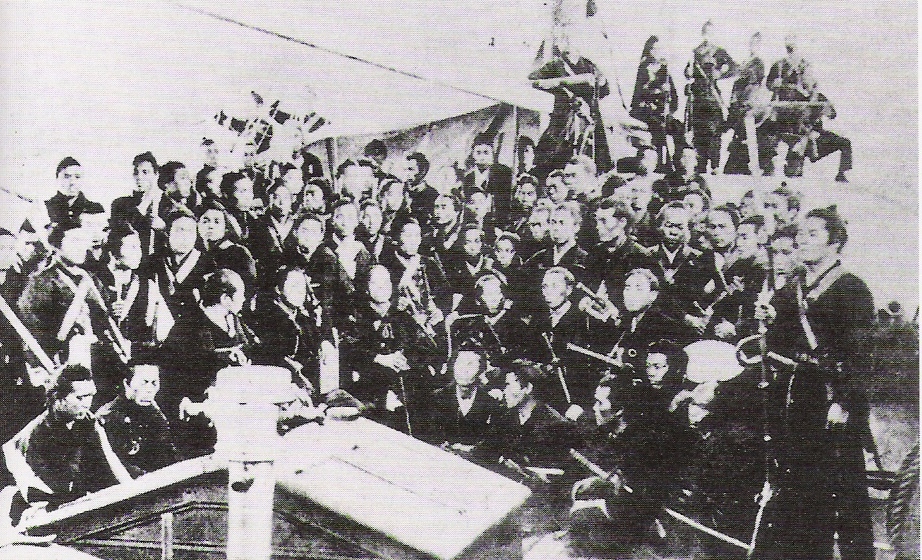 |
Troops of the
former bakufu being transported to Ezo (Hokkaido) in 1868 |
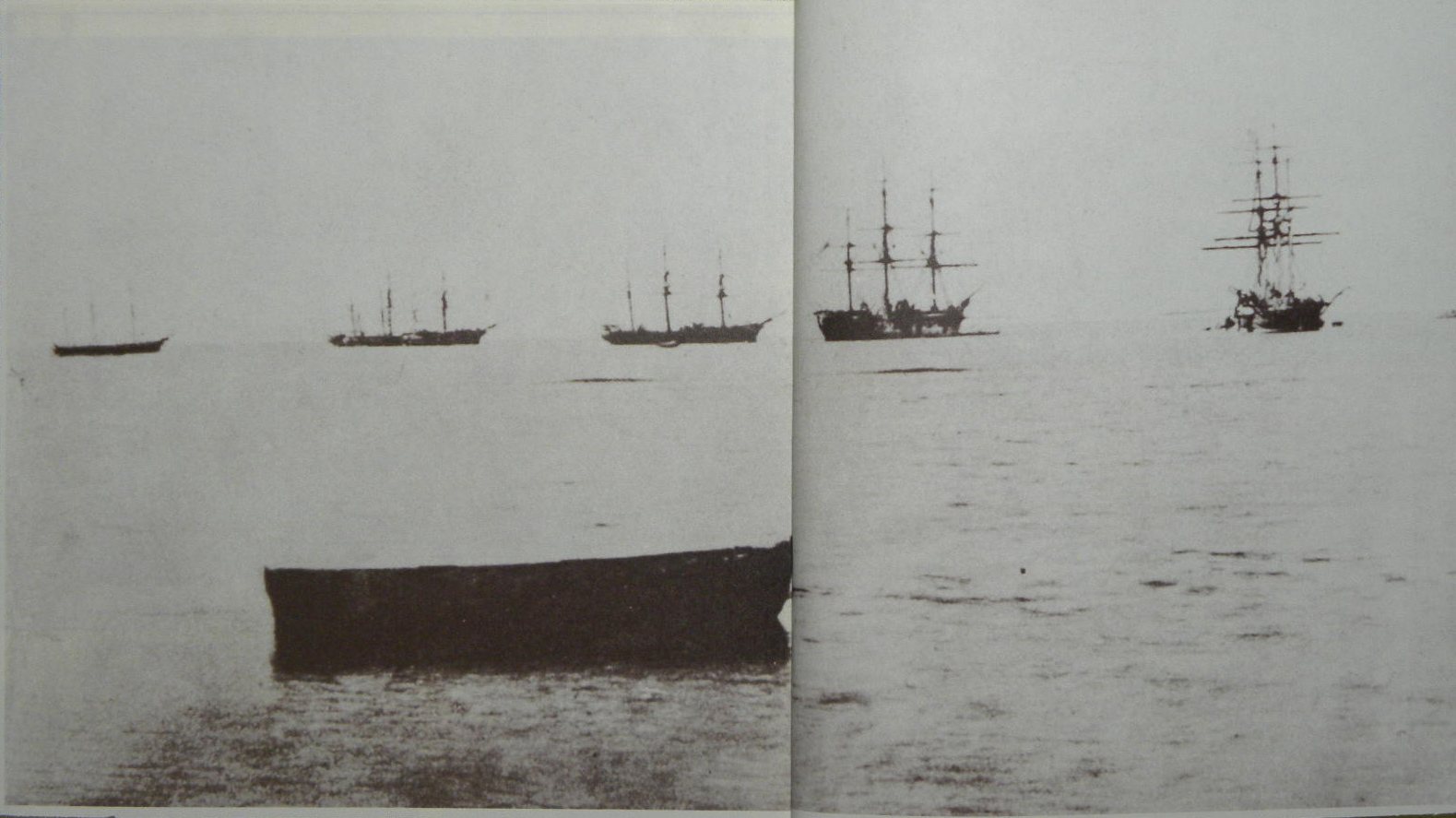 |
(From left to
right) The ships Kaiten, Kaiyō, Kanrin, Chōgei, Mikaho, part of the
fleet led by Enomoto Takeaki, while anchored off Shinagawa shortly
before their departure |
 |
The governmental
building of the Republic of Ezo at Goryōkaku, formerly the offices of
the Hakodate bugyō |
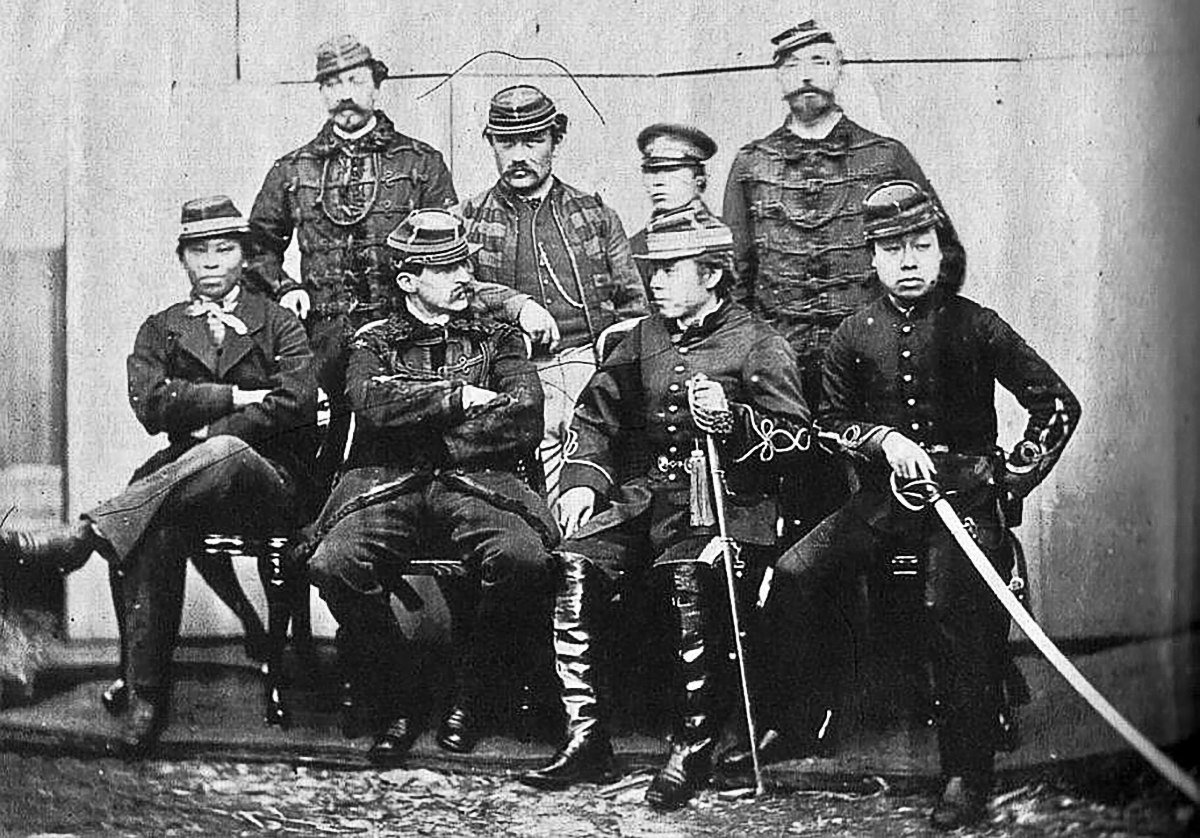 |
The French
military advisors and their Japanese allies in Ezo. Front row, second
from left: Jules Brunet, turning towards Matsudaira Tarō 顧問団と榎本軍。前列左から細谷安太郎、ジュール・ブリュネ、松平太郎、田島金太郎、後列左からアンドレ・カズヌーヴ、ジャン・マルラン、福島時之助、ア ルテュール・フォルタン。画像中の人物にカーソルを合わせると名前が表示され、クリックでリンク先に飛びます。 |
 |
The Naval Battle
of Hakodate Bay, May 1869; in the foreground, Kasuga and Kōtetsu
of the Imperial Japanese Navy. |
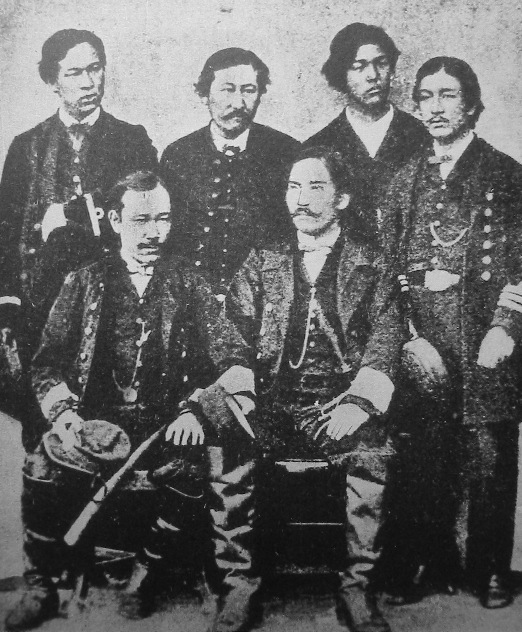 |
Leaders of the
Republic of Ezo, with the President Enomoto Takeaki (seated, right). 後列左から小杉雅之進、榎本対馬、林董三郎、松岡磐吉、前列左から荒井郁之助、榎本武揚 |
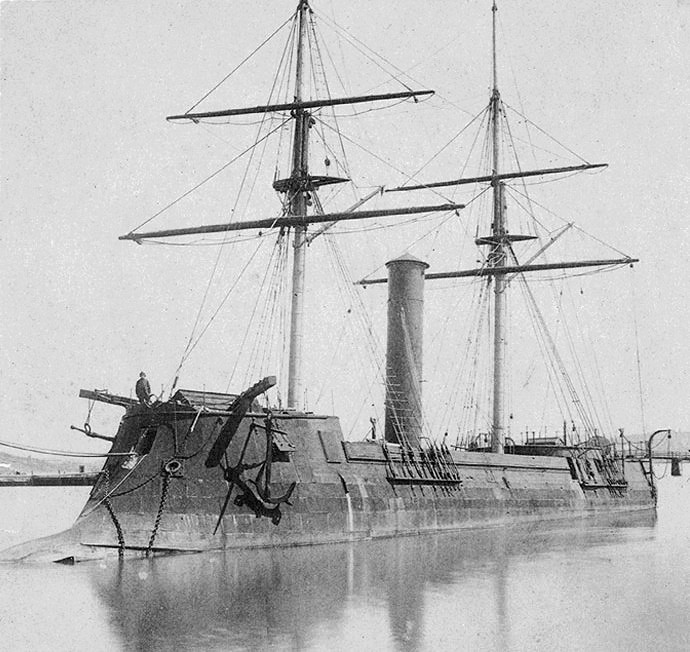 |
アメリカ軍艦ストーンウォール(後の東艦=あずまかん) |
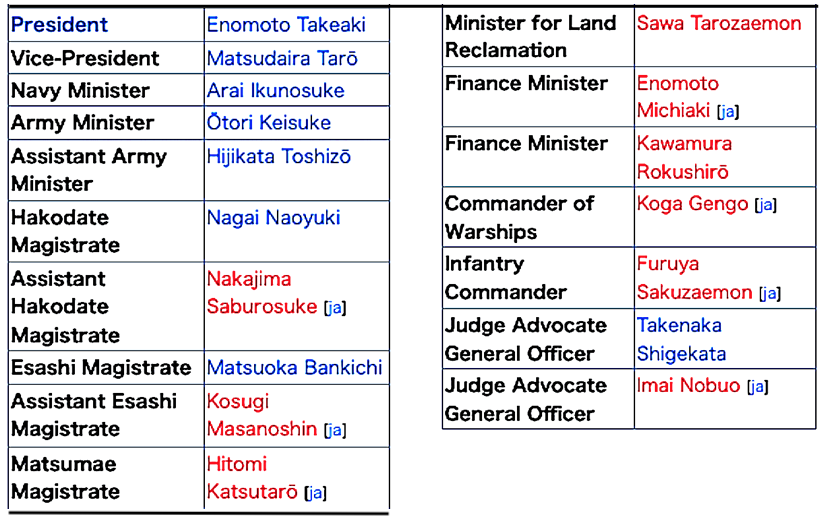 |
戊辰戦争(ぼしんせんそう、慶応4年 / 明治元年〈1868年 [2]〉 - 明治2年〈1869年〉)は、王政復古を経て新政府を樹立した明治天皇側(薩摩藩・長州藩・土佐藩らを中核とした新政府軍)と、旧幕府軍・奥羽越列藩同 盟・蝦夷共和国(幕府陸軍・幕府海軍)が戦った日本最大の内戦[3]。名称は慶応4年/明治元年の干支が戊辰であることに由来する。明治天皇側(新政府 軍)が勝利し、国内に他の交戦団体が消滅したことにより、列強が条約による内戦への局外中立を解除し、これ以降、同政府が日本を統治する合法政府として国 際的に認められることとなった[4]。
The Boshin War
(戊辰戦争, Boshin Sensō, lit. "War of the Year of the Yang Earth Dragon"),
sometimes known as the Japanese Revolution or Japanese Civil War, was a
civil war in Japan fought from 1868 to 1869 between forces of the
ruling Tokugawa shogunate and those seeking to return political power
to the Imperial Court. When the Boshin War began, Japan was already
modernizing, following the same course of advancement as that of the
industrialized Western nations. Since Western nations, especially the
United Kingdom and France, were deeply involved in the country's
politics, the installation of Imperial power added more turbulence to
the conflict. Over time, the war has been romanticized as a "bloodless
revolution", as the number of casualties was small relative to the size
of Japan's population. However, conflicts soon emerged between the
western samurai and the modernists in the imperial faction, which led
to the bloodier Satsuma Rebellion.
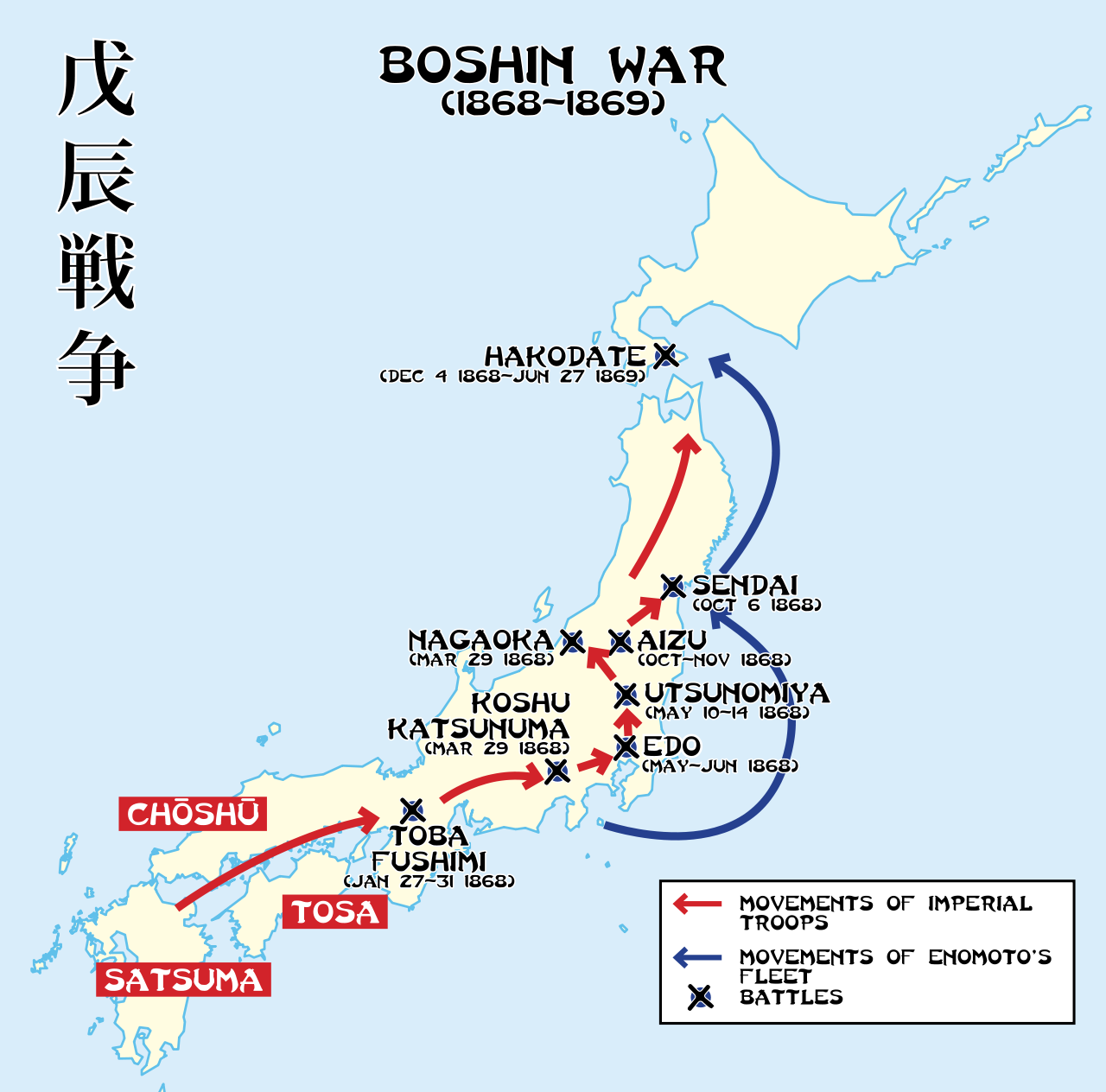
リンク
文献
その他の情報
Copyleft, CC, Mitzub'ixi Quq Chi'j, 1997-2099